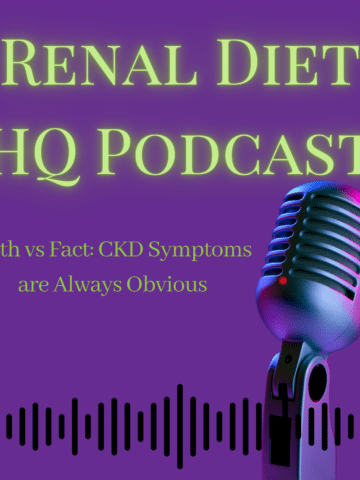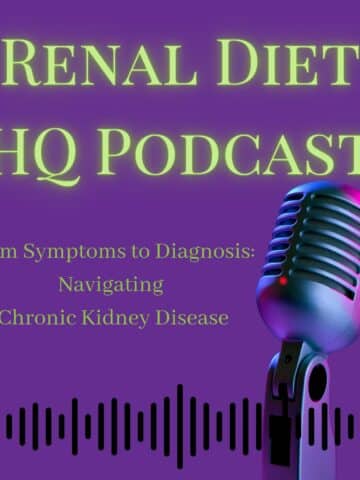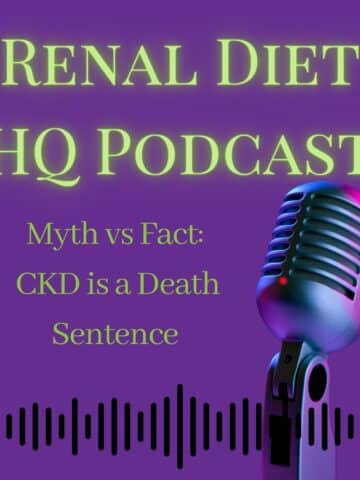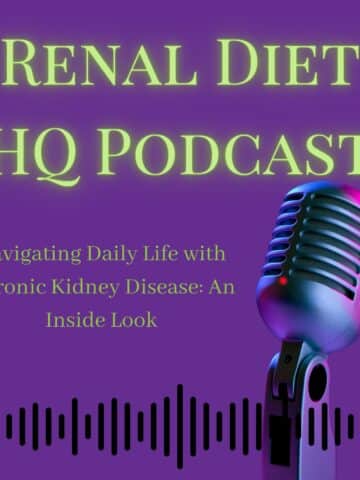RDHQ Podcast 104: Why You Need To Stop Using The Lists Of Foods The Nurse Gave You (Do This Instead)
Podcast: Play in new window | Download
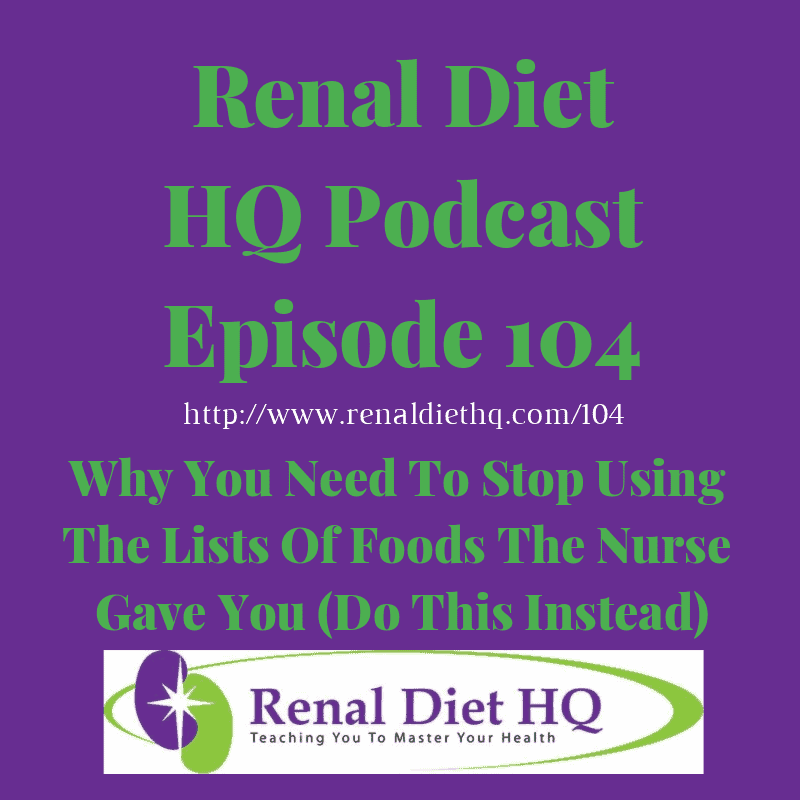
I wanted to talk today because I'm talking about something not to do because it's something that I recently had an epiphany about and what's going wrong and making people like have really such a hard time eating healthy and following their kidney diet is because of this concept of lists.
I realized that this list of foods that the nurse is giving you or the doctor is giving you when you got diagnosed is outdated. You might not have even realized that but that's an outdated concept and it's not the current standard it's not the current evidence-based that it's making you afraid to even eat something like as simple as a cherry tomato because you're afraid of the potassium in it and I think it really has to stop.
Let's go over this. If you are using a list of foods as what not to eat as a way to restrict your diet and keep your kidneys healthy, I believe that that's the wrong way to do it. I tell you not to do something is that not the only thing you think about. I don't know how many people have told me that they can't eat potatoes anymore and that's all they think about so.
I realized that you think that it's the right thing to do because your doctor's office said it or because you read it on the internet or that's what a lot of the old information used to be.
Not everybody's like internal medicine doctors or whatever up to date on the latest KDOQI Guidelines so that's a lot of people giving this concern so that's kind of why I wanted to call it out today. Those guidelines that used to say to restrict potassium would say. They give you this list and they say to restrict this potassium and that's what's on the list is high potassium fruits and vegetables and it's been updated those guidelines and now they're different.
Now, what they say is that you need to manage your potassium only if you have elevated potassium levels which I'm willing to guess that when you got initially diagnosed with CKD that they didn't even test your potassium levels. So, who knows how many times that the list was copied and handed out you know since the 1990s and they didn't even pay attention to you like your specific needs.
If you need to restrict potassium or you need to restrict phosphorus because those levels are elevated you certainly should. Don't take this as you know not to do that but if you haven't been told that your potassium is high then you really don't need to restrict that. What do you need to do? What do you need to manage?
It's that list of foods is not going to help you slow down the progression of your kidney disease. It's only basically slowing your progression of making any progress with your diet.
Let's talk about what you should do. Let's say that the KDOQI Guidelines which are the Kidney Disease Outcome Quality Initiative Guidelines show that potassium and phosphorus are not the first things that need to be limited or watched or managed.
Again, should be managed if your blood levels are high but if they're not then what you should do is this what should you do instead. Watch your protein and your salt intake. Now, really? It's that simple? That's it! That's where you start. You should pretty much you can still eat all the fruits and vegetables you don't need to throw all those outdoors and I eat all these colorful plates and stuff. You really need those to fill in that extra split space on the plate.
What is protein?
Meat, a lot of dairy like cheese and milk is protein and you should eat you know three to four ounces of meat at a meal at your lunch and your dinner. Three to four ounces, three ounces the size of the palm of your hand and you know maybe about that thick and that way that's the portion size and then you fill in the rest of that plate with those lettuce and peppers and tomatoes and you know if you're concerned so I wouldn't go overboard you need to fill in that plate with other things like potatoes and rice and vegetables so you can have been full without that extra protein that you're limited and your sodium. That's probably not where you got told to get started but really that's what the guidelines say you should start. And so you're trying to fill up you know that plate with those higher fiber things like salads, veggies, and fruits.
You also should toss the salt shaker you should not use salt on your food, you could not add salt to your food at the table or at the stove or wherever else you're cooking it you know as a traditional. You want to read all your spices and make sure that they don't have extra salt in them that they're not made with salt like using garlic powder instead of garlic salt, using salt-free spices. I do sell those over on nickannyskitchen.com but you really just want to get some more oomph in there without the salt and some zest and some peppery kind of flavorings added so more onion and garlic too.
I love onion and garlic. I think they make a great addition to any recipe but I know a lot of people talk to me in there like I love onion and garlic. Add more of that. Add that flavor into your meal just don't use onion salt use onion powder or use actual onions. But using less salt takes a little bit to get used to. We've had so many things processed and so many things that already have the salt in them and so it's hard to get used to but then you'll notice yourself in like a week or two so it'll kind of be bland, you add that pepper, you add Tabasco that type of thing and that will make it a little bit more seasonably flavorful plus you're adding those fruits and vegetables and then you get something that salty and all of a sudden you're like "oh!"
I think I may have told the story before but my family we eat low-sodium bacon when we eat bacon and so we'll go to a restaurant and we'll eat like the regular bacon that's on the cafe or whatever and it's like "oh! That's really salty!" So, you will get used to it it's not the easiest thing but really if you add those vegetables and those fruits that you've been keeping off because of that list then you're going to be in a much better space have much more flavor for a while until you see that your potassium is changing.
The biggest change?
What's happening is protein is creating waste product in your blood. Not potassium, not fruits and vegetables. It's the protein so you get that extra waste product in your blood and your kidneys can't clear that out as quickly so that's why you decrease the amount of protein because then you don't have as much waste products and your
kidneys have an easier time managing it and then you're still getting those vitamins and minerals and nutrients that you need from fruits and vegetables and potatoes and all those other things so now you don't have like this very limited plate with almost nothing to eat.
All of a sudden, you have this smaller portion of meat or protein but you have more food on your plate because you can add those things and we all know you need fiber and I don't know how many times people tell me like all of a sudden it's not the healthy diet that they've been told to eat all along and the reality is is that that's because
they may have been told incorrectly that they need the limit potassium first and what you really need to limit is the protein and salt. Mrs. Dash is a great just all-around seasoning. She has a couple that are a little spicier so you can grab that in the store.
I would just start there and realize that it's going to take some time to transition but that transition is a very important part of your process because that salt is going to lower your blood pressure and lower the amount of fluid that your body retains because your kidneys are not going to have to manage that as much.
Blood pressure is huge when it comes to how your kidneys filter. If there's a lot of blood pressure, if you have high blood pressure it's damaging those little nephrons that are filtering your kidneys blood so damaging them making it harder for them to filter leads to more difficulty with your kidney disease so you want to decrease protein and salt.
I'm wondering, you might be wondering for a few more details about what this is about. I'm going to teach this and I have a better way to teach you kind of more than this so not just don't you know listen to your nurse but also other things like what to do so how to approach meal planning besides having list of foods that you can and can't eat and it's one of those little pet peeves of mine that drives me crazy when people are like I have this list of foods and it's not because you didn't know better.
I mean it's not because you knew you got told by a source that you trust and respect to follow this list but what you need to know is that maybe that's not the best solution anymore that managing your protein is the best and especially when you have early-stage kidney disease but I have a program coming out in a couple weeks February 17th and I'm excited to tell you a little bit about it. It's going to be called Love Your Kidneys Delicious CKD Meal Planning and my goal is that you will be - by the end of the time do your meal planning for chronic kidney disease in 15 minutes a day or 15 minutes a week to do your meal planning and then from that you're going to also do your meal grocery shopping and stuff like that so not promised in 15 minutes for grocery shopping although if you do online grocery shopping. It hopes to speed that up. So, let's see.
There's a way to jump on the Waiting List. You may already be on the Waiting List if you are, great! Thank you. I will get you more information coming soon. If not head on over to renaldiethq.com/mpckd and now put on the Waiting List and I've got some great videos coming for you that are gonna be free so no worries.
Questions:
Nancy: Why does most the salt-free seasoning contain crush red pepper? I do not like spicy.
Nancy, they're just trying to give you that zest without really doing you know having the salt. Like I said before a little bit of onion, a little bit of that toasted flavor, adding some garlic so you may find that that's you know gonna be a good substitution for the salt. If you find it really hard to find just try not to try to buy the lower sodium stuff; try to not add it at the table. There are truly some recipes that you need to have a little bit of salt for them to work but usually not as much as the recipe asks for. Just try not to add in your cooking.
When I was growing up, we would put salt so we'd make corn on the cob and boil it in the water and then my grandma would a whole stick of butter in there are probably margarine because she likes margarine and then when you take it to the table and you to add more margarine. I just finally figured out okay maybe I don't need to
do margarine in dish while I'm cooking it I can just add a little bit at the table. You seem to find that balance but I hope that helps a little bit.
Diane says "Oh grow your own herbs, dehydrate and grind them." That's an excellent idea and you can have this little herb gardens in your kitchen and I love fresh herbs they are so good and you don't even have to dehydrate them all the time but it is helpful but you grab them you put them in there. I love basil, I love oregano, I love cilantro too. I know some people think it tastes like suits so but it doesn't to me.
"Where do I find these new guidelines you're referring to?"
They're called the KDOQI Guidelines and if you just google KDOQI, you will see that in there there's it's extensive set of guidelines 500 or more pages and you just need to look for the Nutritional Guidelines and they talk about how you should limit protein and sodium and then as you progress in kidney disease once your last start showing that you have potassium restriction then you limit that potassium and then if you have a phosphorus elevated phosphorus levels then you should limit the phosphorus. But for the most part, I'm trying to think what the other there's another set of guidelines too but I can't think of the name off the top of my head.
Cindy: What do you do when you're eating out?
When you're eating out, I recommend a couple things so you look at the menu ahead of time. You ask them not to add salt when they're preparing it and you also kind of have a couple go tos that you can use that are not as salty.
Know that the sauces usually are their source of a lot of sodium but also the highly processed foods. If you're getting like a mixed dish or something or something that comes with gravy on it ask for that on the side. You know do just a little bit of it. Those are some of the things that I do to help with eating out to lower the sodium levels of those foods. Just something as simple as asking them not to add salt when they're cooking it on the grill will make a huge difference because they just tend to shake and put it on everything.
Diane says "salt-free butter." Excellent point! Sal-free butter is great and very helpful and obviously a simple like swap. Just don't use don't buy the salted butter you use the salt-free butter and you're in good shape.
Okay, so I just want to remind you next video I'm doing this Saturday and I'm going to talk about better options when you're making a meal plan. Some that are options, some better choices and ways to do that a little bit improved and I look forward to that and I'll ask you if you wouldn't mind sharing this with your friends and families if they're interested in this kind of thing and head on over to the website renaldiethq.com/mpckd to learn more to get on the Waiting List. I'll be giving you more information. Again, that's coming out February 17th. It's going to talk of your kidneys, delicious CKD meal planning.
Risa: What is phosphorus and what foods have it?
Phosphorus is it's actually a mineral that's part of your bones. Your bones or calcium and phosphorus combined and phosphorus can be a lot in like beans or meat products. One of the best things that you can do and milk also has a lot of phosphorus so does regular dark-colored sodas. If you drink soda you'd want to drink the light color sodas.
But again you don't have to limit phosphorus unless you have elevated phosphorus levels or like stage 5 End-Stage Renal Disease but phosphorus tends to be poorly absorbed out of normal food products, out of natural food products but it is highly absorbed when it's an inactive form or it's an added phosphorus not inactive, inorganic is the right word. When it is added to a product as like a flavor enhancer or to help process it then it's really helpful for people and it can be a way that you get a lot of... Your body absorbs out at like 95 percent so you want to avoid inorganic phosphorus which you can when you're reading the labels. You're looking in the nutrient in the Ingredient section which I don't have what in front of me but when you're looking in the ingredient section you are looking for the word PHOS phosphorus so it may say monophosphatase which would mean it's got phosphorus that means it added phosphorus you want to pick a better a different version of that product that doesn't have added phosphorus.

